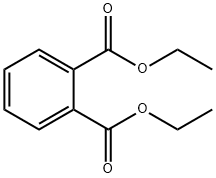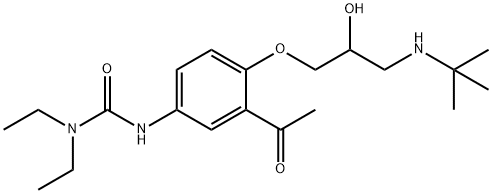Diethyl pyrocarbonate
Synonym(s):DEPC;DEP;Diethyl dicarbonate;Diethyl oxydiformate;Diethyl Oxydiformate, DEPC
- CAS NO.:1609-47-8
- Empirical Formula: C6H10O5
- Molecular Weight: 162.14
- MDL number: MFCD00009106
- EINECS: 216-542-8
- SAFETY DATA SHEET (SDS)
- Update Date: 2024-12-18 14:07:02

What is Diethyl pyrocarbonate?
Chemical properties
liquid
The Uses of Diethyl pyrocarbonate
Diethyl pyrocarbonate may be used in the following studies:
- For the modification of histidyl residues in proteins.
- As a nuclease inhibitor, for the extraction of undegraded nucleic acids from etiolated and green plant tissues.
- For the modification of linear and supercoiled plasmid DNAs.
- As a chemical probe to investigate the secondary structure in negatively supercoiled DNA.
- For cabethoxylation of histidine residues of actin.
The Uses of Diethyl pyrocarbonate
Modification reagent for His and Tyr residues in proteins. Robust probe for structural disruptions in dsDNA, reacting with fully or partially unstacked bases.1
The Uses of Diethyl pyrocarbonate
Gentle esterifying agent. Preservative for wines, soft drinks, fruit juices.
What are the applications of Application
Diethyl Pyrocarbonate is an inhibitor of ryanodine binding at the ryanodine/Ca2+ channel.
Definition
ChEBI: The diethyl ester of dicarbonic acid.
General Description
Diethyl pyrocarbonate (DEP) is a bactericidal agent and decomposes in water to CO2 and ethanol. DEP inhibits enzymes such as DNase and RNase without affecting nucleic acids. It is useful for the preparation of mRNA from tissues.
Biochem/physiol Actions
Inactivates RNase in solution at about 0.1% (v/v), thus protecting RNA against degradation.
Safety Profile
Poison by ingestion, inhalation, and intraperitoneal routes. Concentrated DEPC is irritating to eyes, mucous membranes, and sh. When heated to decomposition it emits acrid smoke and fumes. See also ESTERS.
Purification Methods
Dissolve the ester in Et2O, wash it with dilute HCl, H2O, dry over Na2SO4, filter, evaporate and distil the residue first in vacuo then at atmospheric pressure. It is soluble in alcohols, esters, ketones and hydrocarbon solvents. A 50% w/w solution is usually prepared for general use. Treat with great CAUTION as DEP irritates the eyes, mucous membranes and skin. [Boehm & Mehta Chem Ber 71 1797 1938, Thoma & Rinke Justus Liebigs Ann Chem 624 30 1959, Beilstein 3 IV 18.]
Properties of Diethyl pyrocarbonate
| Melting point: | 69℃ |
| Boiling point: | 93-94 °C18 mm Hg(lit.) |
| Density | 1.12 g/mL at 20 °C |
| refractive index | n |
| Flash point: | 157 °F |
| storage temp. | 2-8°C |
| solubility | 95% ethanol: soluble4.5g/10 mL, clear, colorless |
| form | Liquid |
| color | APHA: ≤20 |
| Water Solubility | slow decomposition |
| Sensitive | Moisture Sensitive |
| Merck | 14,7998 |
| BRN | 637031 |
| Stability: | Combustible. Unstable - readily decomposes. Incompatible with strong oxidizing agents, strong acids, strong reducing agents, strong bases, ammonia. |
| CAS DataBase Reference | 1609-47-8(CAS DataBase Reference) |
| NIST Chemistry Reference | Diethyl pyrocarbonate(1609-47-8) |
| EPA Substance Registry System | Dicarbonic acid, diethyl ester (1609-47-8) |
Safety information for Diethyl pyrocarbonate
| Signal word | Warning |
| Pictogram(s) |
 Exclamation Mark Irritant GHS07 |
| GHS Hazard Statements |
H302:Acute toxicity,oral |
| Precautionary Statement Codes |
P264:Wash hands thoroughly after handling. P264:Wash skin thouroughly after handling. P270:Do not eat, drink or smoke when using this product. P301+P312:IF SWALLOWED: call a POISON CENTER or doctor/physician IF you feel unwell. P501:Dispose of contents/container to..… |
Computed Descriptors for Diethyl pyrocarbonate
| InChIKey | FFYPMLJYZAEMQB-UHFFFAOYSA-N |
Diethyl pyrocarbonate manufacturer
Anand Agencies
New Products
(S)-3-Aminobutanenitrile hydrochloride 4-Methylphenylacetic acid N-Boc-D-alaninol N-BOC-D/L-ALANINOL Tert-butyl bis(2-chloroethyl)carbamate N-octanoyl benzotriazole 3-Morpholino-1-(4-nitrophenyl)-5,6-dihydropyridin- 2(1H)-one Furan-2,5-Dicarboxylic Acid S-2-CHLORO PROPIONIC ACID ETHYL ISOCYANOACETATE 2-Bromo-1,3-Bis(Dimethylamino)Trimethinium Hexafluorophosphate 4-IODO BENZOIC ACID 3-NITRO-2-METHYL ANILINE 1-(2,4-DICHLOROPHENYL) ETHANAMINE (2-Hydroxyphenyl)acetonitrile 4-Bromopyrazole 5,6-Dimethoxyindanone 2-(Cyanocyclohexyl)acetic acid 4-methoxy-3,5-dinitropyridine 1-(4-(aminomethyl)benzyl)urea hydrochloride 2-aminopropyl benzoate hydrochloride diethyl 2-(2-((tertbutoxycarbonyl)amino) ethyl)malonate tert-butyl 4- (ureidomethyl)benzylcarbamate Ethyl-2-chloro((4-methoxyphenyl)hydrazono)acetateRelated products of tetrahydrofuran








You may like
-
 Diethyl pyrocarbonate, 98% CAS 1609-47-8View Details
Diethyl pyrocarbonate, 98% CAS 1609-47-8View Details
1609-47-8 -
 Diethyl Pyrocarbonate (DEPC) for molecular biology CAS 1609-47-8View Details
Diethyl Pyrocarbonate (DEPC) for molecular biology CAS 1609-47-8View Details
1609-47-8 -
 Diethyl pyrocarbonate 95% CAS 1609-47-8View Details
Diethyl pyrocarbonate 95% CAS 1609-47-8View Details
1609-47-8 -
 Diethyl pyrocarbonate 98% CAS 1609-47-8View Details
Diethyl pyrocarbonate 98% CAS 1609-47-8View Details
1609-47-8 -
 Diethyl pyrocarbonate 95% CAS 1609-47-8View Details
Diethyl pyrocarbonate 95% CAS 1609-47-8View Details
1609-47-8 -
 Diethyl dicarbonate CAS 1609-47-8View Details
Diethyl dicarbonate CAS 1609-47-8View Details
1609-47-8 -
 Diethyl Pyrocarbonate CAS 1609-47-8View Details
Diethyl Pyrocarbonate CAS 1609-47-8View Details
1609-47-8 -
 Diethyl pyrocarbonate CAS 1609-47-8View Details
Diethyl pyrocarbonate CAS 1609-47-8View Details
1609-47-8